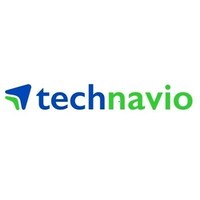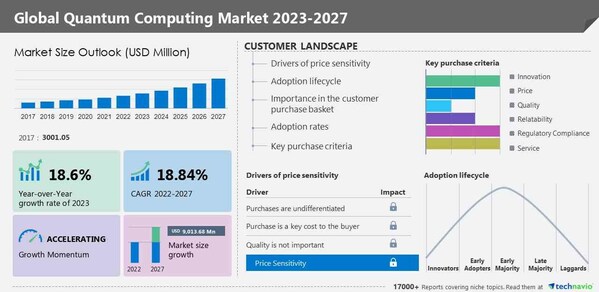
According to Technavio, the global quantum computing market size is estimated to grow by USD 9.01 billion from 2022 to 2027. The market is estimated to grow at a CAGR of 18.84% during the forecast period. Moreover, the growth momentum will accelerate. The growing use of quantum cryptography is driving market growth. With the use of quantum cryptography, critical data can be transmitted with a high level of security. Quantum computers have high processing speeds and efficiently process vast amounts of encrypted data. Governments of many countries have invested large amounts in the development of highly secure quantum computers. These factors will fuel the growth of the market during the forecast period. The report includes historic market data from 2017 to 2021. In 2017, the quantum computing market was valued at USD 3,001.05 million. The report provides a comprehensive analysis of growth opportunities at regional levels, new product launches, the latest trends, and the post-pandemic recovery of the global market.
For more insights on the market
|
Report Coverage |
Details |
|
Page number |
143 |
|
Base year |
2022 |
|
Historic period |
2017-2021 |
|
Forecast period |
2023-2027 |
|
Growth momentum & CAGR |
Accelerate at a CAGR of 18.84% |
|
Market growth 2023-2027 |
USD 9,013.68 million |
|
Market structure |
Fragmented |
|
YoY growth 2022-2023(%) |
18.6 |
|
Regional analysis |
North America, APAC, Europe, South America, and Middle East and Africa |
|
Performing market contribution |
North America at 38% |
|
Key countries |
US, China, Japan, India, and Germany |
Geographical Analysis
Based on geography, the global quantum computing market is segmented into North America, APAC, Europe, South America, and Middle East and Africa. The report provides actionable insights and estimates the contribution of all regions to the growth of the global quantum computing market. North America is estimated to account for 38% of the growth of the global market during the forecast period. The growth of this segment is primarily driven by factors such as the presence of numerous customers based in the US. US-based firms have access to quantum computers on immediate release. They also have high economies of scale and have the finances and resources to adopt these technologies. These factors will drive the growth of the market in the region during the forecast period.
Segment overview
Technavio has segmented the market based on deployment (cloud and on-premise) and end-user (aerospace and defense, government, IT and telecom, and others).
- The cloud segment will account for a significant share of the market’s growth during the forecast period. Firms can access quantum computing systems through a cloud network, which lowers the need for hardware and software. The growth of this segment is attributed to factors such as the low cost of entry. Buyers do not have to invest in hardware. Moreover, the speed of setup and implementation is high. These factors will fuel the growth of this segment during the forecast period.
The growth of AI and machine learning is a key trend in the market.
AI and machine learning are expected to be some of the biggest applications of quantum computers. Quantum computing processor chips will be used in AI applications to compute data at high speeds efficiently. The use of AI will help solve issues related to optimization and sampling. These factors will support the growth of the market during the forecast period.
- The short lifecycle of supercomputers is challenging market growth.
Find more insights in a sample report!
Analyst Review
Quantum computing represents a paradigm shift in computational power, promising unprecedented capabilities in various industries, including banking and finance services. Its potential to revolutionize portfolio management and financial risk analysis is attracting significant attention from both established institutions and emerging quantum technology start-ups.
One of the most significant challenges is stability and error correction. Researchers at the Quantum Artificial Intelligence Laboratory (QuAIL) are tirelessly working on addressing stability and error correction issues to make quantum computers more reliable. The manipulation of physical qubits and the development of logical qubits are pivotal in this pursuit, leveraging principles of quantum mechanics.
The Department of Defense recognizes the transformative potential in areas such as cybersecurity solutions and fraudulent activities detection. As such, it’s actively involved in quantum technology monitor research and investments to maintain a strategic advantage.
In the biopharmaceuticals sector, it holds promise for accelerating drug discovery processes. By harnessing its immense computational power, researchers can simulate molecular interactions more accurately, potentially leading to breakthroughs in medicine.
However, the market isn’t devoid of challenges. Talent shortage is a pressing issue, with demand for skilled professionals in quantum mechanics and artificial intelligence (AI) outpacing supply. Governments are thus increasing investments in quantum technology education to bridge this gap.
Furthermore, patent filings related to quantum technology are on the rise, reflecting the fierce competition in this space. Companies are eager to protect their innovations, especially in areas like teleportation and blockchain technology integration with quantum computing.
Despite these challenges, the quantum computing market is witnessing remarkable growth, driven by a convergence of factors such as technological advancements, increased funding, and a growing ecosystem of quantum technology start-ups. As the industry continues to evolve, it promises to reshape the landscape of computing and unlock unprecedented possibilities across various sectors.
Find more insights in a sample report!
Related Reports:
The edge computing market is estimated to grow at a CAGR of 24.74% between 2022 and 2027. The size of the market is forecasted to increase by USD 9,928.42 million.
The mobile edge computing market size is expected to rise by USD 1.60 billion from 2021 to 2026, and the market’s growth momentum will accelerate at a CAGR of 30.21%.
TOC
- Executive Summary
- Market Landscape
- Market Sizing
- Historic Market Size
- Five Forces Analysis
- Market Segmentation by Deployment
- Market Segmentation by End-User
- Customer Landscape
- Geographic Landscape
- Drivers, Challenges, and Trends
- Company Landscape
- Company Analysis
- Appendix
About Us
Technavio is a leading global technology research and advisory company. Their research and analysis focus on emerging market trends and provide actionable insights to help businesses identify market opportunities and develop effective strategies to optimize their market positions. With over 500 specialized analysts, Technavio’s report library consists of more than 17,000 reports and counting, covering 800 technologies, spanning across 50 countries. Their client base consists of enterprises of all sizes, including more than 100 Fortune 500 companies. This growing client base relies on Technavio’s comprehensive coverage, extensive research, and actionable market insights to identify opportunities in existing and potential markets and assess their competitive positions within changing market scenarios.
Contact
Technavio Research
Jesse Maida
Media & Marketing Executive
US: +1 844 364 1100
UK: +44 203 893 3200
Email: media@technavio.com
Website: www.technavio.com/
SOURCE Technavio







